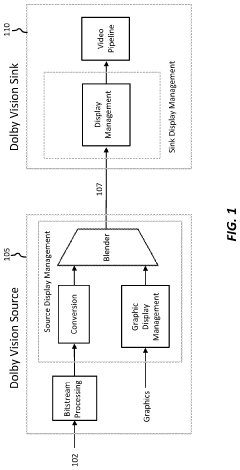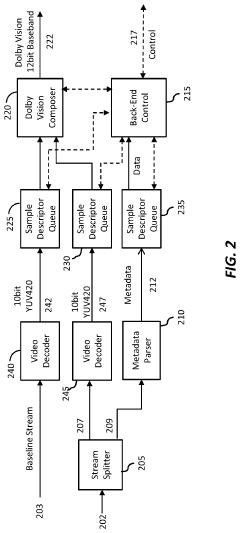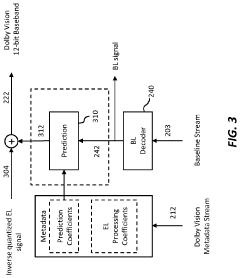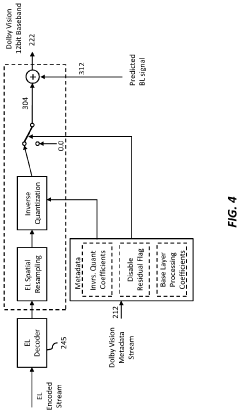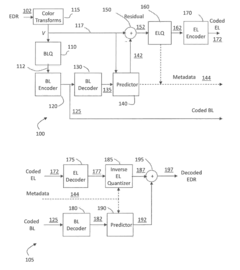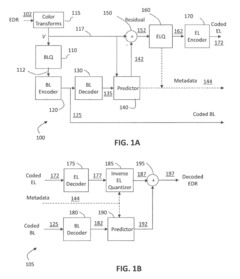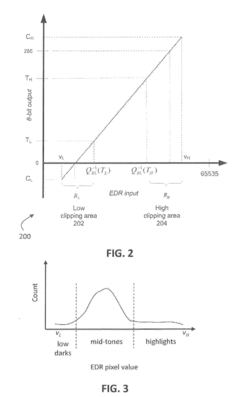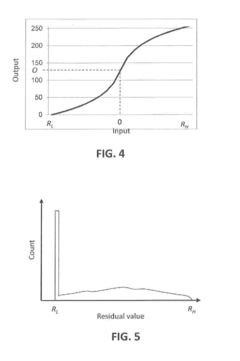Dolby Vision-Enhanced Workflows for Film Directors
JUL 30, 20259 MIN READ
Generate Your Research Report Instantly with AI Agent
Patsnap Eureka helps you evaluate technical feasibility & market potential.
Dolby Vision Evolution
Dolby Vision has undergone significant evolution since its introduction in 2014, marking a transformative journey in the realm of high dynamic range (HDR) imaging technology. Initially developed to enhance the visual experience in cinema and high-end home entertainment systems, Dolby Vision has expanded its reach across various platforms and devices.
The early stages of Dolby Vision focused on implementing the technology in professional cinema environments. This phase involved the development of specialized hardware and software solutions to capture, process, and display HDR content in theaters. The technology quickly gained traction among filmmakers and cinematographers due to its ability to preserve creative intent and deliver a more immersive viewing experience.
As consumer electronics evolved, Dolby Vision adapted to meet the demands of home entertainment. The technology was integrated into high-end televisions, offering consumers a taste of cinema-quality visuals in their living rooms. This period saw the refinement of Dolby Vision's dynamic metadata capabilities, allowing for frame-by-frame optimization of brightness, color, and contrast.
The next significant milestone in Dolby Vision's evolution was its expansion into the mobile and streaming domains. With the proliferation of smartphones and tablets capable of displaying HDR content, Dolby Vision was optimized for smaller screens and varying viewing conditions. Simultaneously, major streaming platforms began adopting Dolby Vision, making it more accessible to a broader audience.
Recent years have witnessed Dolby Vision's venture into new territories, including gaming and augmented reality (AR) applications. The technology has been adapted to enhance real-time rendering in video games, providing gamers with more vibrant and lifelike visuals. In the AR space, Dolby Vision is being explored as a means to improve the blending of digital content with the real world.
Throughout its evolution, Dolby Vision has consistently pushed the boundaries of what's possible in digital imaging. The technology has progressed from a 12-bit color depth to support for 12-bit+ workflows, enabling an even wider color gamut and more precise gradations. Additionally, advancements in compression algorithms have allowed for more efficient delivery of Dolby Vision content across various bandwidth constraints.
The ongoing development of Dolby Vision has also seen improvements in its integration with other audiovisual technologies. This includes seamless compatibility with Dolby Atmos for a comprehensive immersive experience and enhanced interoperability with different HDR standards to ensure broader content availability.
As Dolby Vision continues to evolve, its focus has shifted towards empowering content creators with more intuitive and efficient tools. This includes the development of software solutions that streamline the HDR grading process and provide real-time previews across multiple display types, enabling directors and cinematographers to maintain greater control over their artistic vision throughout the production pipeline.
The early stages of Dolby Vision focused on implementing the technology in professional cinema environments. This phase involved the development of specialized hardware and software solutions to capture, process, and display HDR content in theaters. The technology quickly gained traction among filmmakers and cinematographers due to its ability to preserve creative intent and deliver a more immersive viewing experience.
As consumer electronics evolved, Dolby Vision adapted to meet the demands of home entertainment. The technology was integrated into high-end televisions, offering consumers a taste of cinema-quality visuals in their living rooms. This period saw the refinement of Dolby Vision's dynamic metadata capabilities, allowing for frame-by-frame optimization of brightness, color, and contrast.
The next significant milestone in Dolby Vision's evolution was its expansion into the mobile and streaming domains. With the proliferation of smartphones and tablets capable of displaying HDR content, Dolby Vision was optimized for smaller screens and varying viewing conditions. Simultaneously, major streaming platforms began adopting Dolby Vision, making it more accessible to a broader audience.
Recent years have witnessed Dolby Vision's venture into new territories, including gaming and augmented reality (AR) applications. The technology has been adapted to enhance real-time rendering in video games, providing gamers with more vibrant and lifelike visuals. In the AR space, Dolby Vision is being explored as a means to improve the blending of digital content with the real world.
Throughout its evolution, Dolby Vision has consistently pushed the boundaries of what's possible in digital imaging. The technology has progressed from a 12-bit color depth to support for 12-bit+ workflows, enabling an even wider color gamut and more precise gradations. Additionally, advancements in compression algorithms have allowed for more efficient delivery of Dolby Vision content across various bandwidth constraints.
The ongoing development of Dolby Vision has also seen improvements in its integration with other audiovisual technologies. This includes seamless compatibility with Dolby Atmos for a comprehensive immersive experience and enhanced interoperability with different HDR standards to ensure broader content availability.
As Dolby Vision continues to evolve, its focus has shifted towards empowering content creators with more intuitive and efficient tools. This includes the development of software solutions that streamline the HDR grading process and provide real-time previews across multiple display types, enabling directors and cinematographers to maintain greater control over their artistic vision throughout the production pipeline.
HDR Market Demand
The demand for High Dynamic Range (HDR) content and technologies has been steadily increasing in recent years, driven by the growing consumer appetite for more immersive and lifelike visual experiences. This trend is particularly evident in the film industry, where directors and cinematographers are increasingly embracing HDR workflows to enhance the visual quality of their productions.
The global HDR market is experiencing significant growth, with projections indicating a substantial increase in market value over the coming years. This growth is fueled by the widespread adoption of HDR-capable displays in homes, theaters, and mobile devices. Consumers are showing a strong preference for HDR content, recognizing the superior image quality, enhanced contrast, and wider color gamut that HDR offers compared to standard dynamic range (SDR) content.
In the film industry, there is a growing demand for HDR-enhanced workflows, particularly those incorporating Dolby Vision technology. Film directors are increasingly recognizing the creative possibilities that HDR offers, allowing them to capture and present their artistic vision with greater fidelity and impact. The ability to showcase a wider range of colors and brightness levels enables directors to create more visually striking and emotionally engaging scenes.
The demand for Dolby Vision-enhanced workflows is driven by several factors. Firstly, the technology's ability to optimize content for a wide range of displays, from high-end cinema screens to consumer televisions, ensures that the director's vision is preserved across various viewing environments. Secondly, the increasing availability of Dolby Vision-compatible streaming platforms and home entertainment systems is creating a larger audience for HDR content, further incentivizing filmmakers to adopt these workflows.
Moreover, the film industry is witnessing a shift towards HDR as a standard for premium content. Major studios and streaming services are investing heavily in HDR production and distribution, recognizing it as a key differentiator in the competitive content landscape. This trend is creating a ripple effect throughout the industry, driving demand for HDR-capable equipment, software, and expertise.
The market demand for HDR technologies extends beyond just the film industry. Television broadcasters, gaming companies, and virtual reality developers are also exploring HDR workflows to enhance their content offerings. This cross-industry adoption is further accelerating the growth of the HDR market and driving innovation in related technologies.
As the demand for HDR content continues to grow, there is an increasing need for standardized workflows and tools that can streamline the HDR production process. This presents opportunities for technology providers to develop solutions that address the specific needs of film directors and other content creators working with HDR formats like Dolby Vision.
The global HDR market is experiencing significant growth, with projections indicating a substantial increase in market value over the coming years. This growth is fueled by the widespread adoption of HDR-capable displays in homes, theaters, and mobile devices. Consumers are showing a strong preference for HDR content, recognizing the superior image quality, enhanced contrast, and wider color gamut that HDR offers compared to standard dynamic range (SDR) content.
In the film industry, there is a growing demand for HDR-enhanced workflows, particularly those incorporating Dolby Vision technology. Film directors are increasingly recognizing the creative possibilities that HDR offers, allowing them to capture and present their artistic vision with greater fidelity and impact. The ability to showcase a wider range of colors and brightness levels enables directors to create more visually striking and emotionally engaging scenes.
The demand for Dolby Vision-enhanced workflows is driven by several factors. Firstly, the technology's ability to optimize content for a wide range of displays, from high-end cinema screens to consumer televisions, ensures that the director's vision is preserved across various viewing environments. Secondly, the increasing availability of Dolby Vision-compatible streaming platforms and home entertainment systems is creating a larger audience for HDR content, further incentivizing filmmakers to adopt these workflows.
Moreover, the film industry is witnessing a shift towards HDR as a standard for premium content. Major studios and streaming services are investing heavily in HDR production and distribution, recognizing it as a key differentiator in the competitive content landscape. This trend is creating a ripple effect throughout the industry, driving demand for HDR-capable equipment, software, and expertise.
The market demand for HDR technologies extends beyond just the film industry. Television broadcasters, gaming companies, and virtual reality developers are also exploring HDR workflows to enhance their content offerings. This cross-industry adoption is further accelerating the growth of the HDR market and driving innovation in related technologies.
As the demand for HDR content continues to grow, there is an increasing need for standardized workflows and tools that can streamline the HDR production process. This presents opportunities for technology providers to develop solutions that address the specific needs of film directors and other content creators working with HDR formats like Dolby Vision.
Dolby Vision Challenges
Despite the numerous advantages Dolby Vision brings to the filmmaking process, directors and their teams face several challenges when implementing this technology. One of the primary obstacles is the complexity of the Dolby Vision workflow, which requires specialized knowledge and training. Many directors and cinematographers are accustomed to traditional color grading processes and may find the transition to Dolby Vision's dynamic metadata approach challenging.
The increased color depth and dynamic range offered by Dolby Vision also present creative challenges. Directors must learn to effectively utilize the expanded palette without overwhelming the viewer or compromising the intended artistic vision. This requires a delicate balance between pushing the boundaries of visual storytelling and maintaining a cohesive aesthetic throughout the film.
Another significant challenge is the need for compatible equipment throughout the production and post-production pipeline. From cameras capable of capturing high dynamic range content to monitors that can accurately display the full range of Dolby Vision, ensuring consistency across all stages of production can be both technically demanding and financially burdensome for productions.
The post-production phase introduces its own set of challenges. Color grading for Dolby Vision requires specialized software and hardware, as well as colorists who are proficient in working with the technology. The process of creating both HDR and SDR versions of the content simultaneously adds complexity and time to the post-production workflow.
Compatibility issues also arise when considering the diverse range of display devices used by audiences. Directors must ensure that their vision translates effectively across various screens, from high-end cinema projectors to consumer-grade televisions and mobile devices. This necessitates careful consideration of how the content will be perceived in different viewing environments.
Furthermore, the archival and distribution of Dolby Vision content present unique challenges. The increased file sizes and specialized formats required for Dolby Vision can strain storage systems and complicate the distribution process, particularly for smaller productions or independent filmmakers.
Lastly, there is the challenge of educating and aligning all stakeholders involved in the filmmaking process. From producers and studio executives to distributors and exhibitors, ensuring that everyone understands the value and requirements of Dolby Vision is crucial for its successful implementation. This educational aspect extends to audiences as well, who may need to be informed about the benefits of seeking out Dolby Vision-enabled content and viewing experiences.
The increased color depth and dynamic range offered by Dolby Vision also present creative challenges. Directors must learn to effectively utilize the expanded palette without overwhelming the viewer or compromising the intended artistic vision. This requires a delicate balance between pushing the boundaries of visual storytelling and maintaining a cohesive aesthetic throughout the film.
Another significant challenge is the need for compatible equipment throughout the production and post-production pipeline. From cameras capable of capturing high dynamic range content to monitors that can accurately display the full range of Dolby Vision, ensuring consistency across all stages of production can be both technically demanding and financially burdensome for productions.
The post-production phase introduces its own set of challenges. Color grading for Dolby Vision requires specialized software and hardware, as well as colorists who are proficient in working with the technology. The process of creating both HDR and SDR versions of the content simultaneously adds complexity and time to the post-production workflow.
Compatibility issues also arise when considering the diverse range of display devices used by audiences. Directors must ensure that their vision translates effectively across various screens, from high-end cinema projectors to consumer-grade televisions and mobile devices. This necessitates careful consideration of how the content will be perceived in different viewing environments.
Furthermore, the archival and distribution of Dolby Vision content present unique challenges. The increased file sizes and specialized formats required for Dolby Vision can strain storage systems and complicate the distribution process, particularly for smaller productions or independent filmmakers.
Lastly, there is the challenge of educating and aligning all stakeholders involved in the filmmaking process. From producers and studio executives to distributors and exhibitors, ensuring that everyone understands the value and requirements of Dolby Vision is crucial for its successful implementation. This educational aspect extends to audiences as well, who may need to be informed about the benefits of seeking out Dolby Vision-enabled content and viewing experiences.
Current Dolby Workflows
01 Enhanced video processing workflows
Dolby Vision-enhanced workflows involve advanced video processing techniques to improve image quality, color accuracy, and dynamic range. These workflows integrate specialized algorithms and tools to optimize content for Dolby Vision-compatible displays, ensuring a superior viewing experience across various devices.- Dolby Vision-enhanced video processing workflows: Workflows incorporating Dolby Vision technology to enhance video processing, including color grading, encoding, and delivery. These workflows enable the creation and distribution of high dynamic range (HDR) content with improved color accuracy and brightness.
- Automated workflow management for Dolby Vision content: Systems and methods for automating the workflow management of Dolby Vision-enhanced content creation and distribution. This includes task scheduling, resource allocation, and quality control processes specific to Dolby Vision requirements.
- Integration of Dolby Vision in cloud-based production environments: Implementation of Dolby Vision workflows in cloud-based production environments, enabling collaborative work, remote access, and scalable processing for HDR content creation and management.
- Quality assurance and validation processes for Dolby Vision workflows: Specialized quality assurance and validation processes designed for Dolby Vision workflows, ensuring that the final content meets the required standards for HDR playback across various devices and platforms.
- Dolby Vision metadata management in production workflows: Techniques for managing and integrating Dolby Vision metadata throughout the production workflow, including creation, modification, and preservation of metadata for optimal HDR content delivery.
02 Automated content creation and adaptation
Automated systems and methods are employed in Dolby Vision workflows to streamline content creation and adaptation processes. These systems can analyze, adjust, and optimize video content for different display capabilities, reducing manual intervention and improving efficiency in content production and distribution.Expand Specific Solutions03 Workflow management and collaboration tools
Specialized workflow management and collaboration tools are integrated into Dolby Vision-enhanced workflows. These tools facilitate seamless communication between team members, track project progress, and ensure consistent quality throughout the content creation and post-production processes.Expand Specific Solutions04 Quality control and verification processes
Dolby Vision workflows incorporate robust quality control and verification processes to ensure that the final content meets the required standards. These processes include automated checks, visual inspections, and specialized tools for assessing color accuracy, dynamic range, and overall image quality.Expand Specific Solutions05 Integration with existing production pipelines
Dolby Vision-enhanced workflows are designed to integrate seamlessly with existing production pipelines and software. This integration allows for efficient adoption of Dolby Vision technology without disrupting established workflows, enabling content creators to leverage their existing tools and expertise while benefiting from enhanced capabilities.Expand Specific Solutions
Key Industry Players
The research on Dolby Vision-enhanced workflows for film directors is at a relatively early stage of development, with the market still emerging. The technology's maturity is progressing rapidly, driven by key players like Dolby Laboratories and Adobe. Major film studios such as 20th Century Studios are exploring implementation, while companies like Flawless Holdings are innovating in related AI-driven visual technologies. The market size is expected to grow significantly as more directors and production houses adopt these advanced workflows to enhance visual storytelling and streamline post-production processes.
Dolby Laboratories Licensing Corp.
Technical Solution: Dolby Laboratories has developed advanced Dolby Vision workflows specifically tailored for film directors. Their system integrates high dynamic range (HDR) and wide color gamut technologies to enhance the creative process. Directors can now work with a broader range of colors and contrasts, allowing for more precise visual storytelling. The workflow includes on-set tools for real-time HDR monitoring, post-production software for fine-tuning, and mastering tools that ensure consistent quality across various display devices[1][3]. Dolby's approach also incorporates machine learning algorithms to optimize the conversion of standard dynamic range (SDR) content to HDR, enabling directors to easily upgrade existing footage[5].
Strengths: Industry-leading HDR technology, comprehensive end-to-end workflow, wide industry adoption. Weaknesses: Proprietary system may limit compatibility with some third-party tools, potentially higher implementation costs.
Adobe, Inc.
Technical Solution: Adobe has integrated Dolby Vision support into its Creative Cloud suite, particularly in Premiere Pro and After Effects. This integration allows film directors to work with Dolby Vision content throughout the post-production process. Adobe's workflow includes tools for color grading, HDR to SDR conversions, and metadata management specific to Dolby Vision[2]. The software provides real-time previews of how content will appear on various display types, from cinema screens to mobile devices. Adobe has also developed AI-powered tools that assist in automating certain aspects of the Dolby Vision workflow, such as shot matching and color consistency across scenes[4].
Strengths: Seamless integration with widely-used editing software, user-friendly interface, regular updates with new features. Weaknesses: Requires subscription to Creative Cloud, may have a learning curve for new users.
Dolby Vision Innovations
Layered representation and delivery of high dynamic range video
PatentActiveUS20190373290A1
Innovation
- The implementation of a layered representation and delivery system for HDR video, utilizing Dolby Vision technology, which includes a base layer and enhancement layer, along with metadata processing to reconstruct HDR signals, ensuring seamless playback on compatible displays.
Layered Decomposition of Chroma Components in EDR Video Coding
PatentActiveUS20160065975A1
Innovation
- A dual-layer EDR video encoder employs joint adaptation of base layer and enhancement layer quantizers, optimizing parameter selection to minimize distortion and bit requirements, allowing for efficient coding and decoding of EDR video streams that can be rendered on both legacy and HDR displays.
Cinematic Impact
Dolby Vision has revolutionized the cinematic experience, offering filmmakers unprecedented control over color, contrast, and brightness. This technology has significantly impacted the way directors approach their craft, enabling them to create more immersive and visually stunning films. The enhanced dynamic range and expanded color gamut provided by Dolby Vision allow directors to capture and present their artistic vision with greater fidelity and precision.
One of the most notable impacts of Dolby Vision on filmmaking is the ability to preserve and enhance the visual integrity of a film across various display devices. This consistency ensures that the director's intended look is maintained, whether the audience is viewing the film in a theater or on a home entertainment system. The technology's ability to adapt to different screens and lighting conditions has given directors more confidence in how their work will be perceived by audiences in diverse viewing environments.
The introduction of Dolby Vision has also influenced the creative process during production and post-production. Directors now have access to a wider palette of colors and tones, allowing for more nuanced and expressive visual storytelling. This expanded range of creative possibilities has led to the development of new cinematographic techniques and styles, pushing the boundaries of what can be achieved visually in film.
Furthermore, Dolby Vision has had a profound effect on the emotional impact of films. The technology's ability to render deep blacks, brilliant highlights, and a vast spectrum of colors enables directors to create more atmospheric and emotionally resonant scenes. This enhanced visual depth can evoke stronger emotional responses from viewers, making the cinematic experience more engaging and memorable.
The adoption of Dolby Vision has also necessitated changes in the collaborative process between directors, cinematographers, and colorists. The technology requires a more integrated approach to color grading and visual effects, encouraging closer cooperation among these professionals throughout the filmmaking process. This collaboration often results in a more cohesive and visually striking final product.
As Dolby Vision continues to evolve and become more widely adopted, its impact on cinematic storytelling is likely to grow. Directors are increasingly exploring the technology's potential to push creative boundaries and deliver more immersive and visually compelling narratives. The ongoing development of Dolby Vision-enhanced workflows promises to further empower filmmakers in their quest to create truly unforgettable cinematic experiences.
One of the most notable impacts of Dolby Vision on filmmaking is the ability to preserve and enhance the visual integrity of a film across various display devices. This consistency ensures that the director's intended look is maintained, whether the audience is viewing the film in a theater or on a home entertainment system. The technology's ability to adapt to different screens and lighting conditions has given directors more confidence in how their work will be perceived by audiences in diverse viewing environments.
The introduction of Dolby Vision has also influenced the creative process during production and post-production. Directors now have access to a wider palette of colors and tones, allowing for more nuanced and expressive visual storytelling. This expanded range of creative possibilities has led to the development of new cinematographic techniques and styles, pushing the boundaries of what can be achieved visually in film.
Furthermore, Dolby Vision has had a profound effect on the emotional impact of films. The technology's ability to render deep blacks, brilliant highlights, and a vast spectrum of colors enables directors to create more atmospheric and emotionally resonant scenes. This enhanced visual depth can evoke stronger emotional responses from viewers, making the cinematic experience more engaging and memorable.
The adoption of Dolby Vision has also necessitated changes in the collaborative process between directors, cinematographers, and colorists. The technology requires a more integrated approach to color grading and visual effects, encouraging closer cooperation among these professionals throughout the filmmaking process. This collaboration often results in a more cohesive and visually striking final product.
As Dolby Vision continues to evolve and become more widely adopted, its impact on cinematic storytelling is likely to grow. Directors are increasingly exploring the technology's potential to push creative boundaries and deliver more immersive and visually compelling narratives. The ongoing development of Dolby Vision-enhanced workflows promises to further empower filmmakers in their quest to create truly unforgettable cinematic experiences.
Dolby Vision Standards
Dolby Vision standards represent a cutting-edge set of specifications for high dynamic range (HDR) video content creation, distribution, and playback. These standards are designed to deliver superior image quality by preserving and displaying a wider range of colors and brightness levels than conventional video formats.
At the core of Dolby Vision standards is the use of dynamic metadata, which allows for frame-by-frame optimization of the HDR content. This dynamic approach ensures that each scene is presented with optimal brightness, contrast, and color, resulting in a more immersive and lifelike viewing experience.
The standards encompass various aspects of the video production and delivery pipeline. For content creation, Dolby Vision provides tools and workflows that enable filmmakers to capture, grade, and master their content in HDR. These tools include specialized color grading software and monitoring solutions that allow for precise control over the expanded color and brightness range.
In terms of distribution, Dolby Vision standards define efficient encoding methods that can deliver high-quality HDR content while maintaining reasonable file sizes and bandwidth requirements. This includes support for both 10-bit and 12-bit color depth, as well as various color spaces such as BT.2020.
For playback, Dolby Vision standards specify the requirements for display devices to accurately reproduce the intended HDR image. This includes guidelines for peak brightness, black levels, and color gamut coverage. The standards also define how devices should interpret and apply the dynamic metadata to optimize the image for specific display capabilities.
Interoperability is a key focus of Dolby Vision standards, ensuring compatibility across different devices and platforms. The standards include provisions for backward compatibility with standard dynamic range (SDR) displays, allowing Dolby Vision content to be viewed on a wide range of devices while still maintaining image quality.
As the film industry continues to embrace HDR technology, Dolby Vision standards play a crucial role in establishing a consistent and high-quality viewing experience. By providing a comprehensive framework for HDR content creation and delivery, these standards empower filmmakers to push the boundaries of visual storytelling and bring their creative visions to life with unprecedented clarity and impact.
At the core of Dolby Vision standards is the use of dynamic metadata, which allows for frame-by-frame optimization of the HDR content. This dynamic approach ensures that each scene is presented with optimal brightness, contrast, and color, resulting in a more immersive and lifelike viewing experience.
The standards encompass various aspects of the video production and delivery pipeline. For content creation, Dolby Vision provides tools and workflows that enable filmmakers to capture, grade, and master their content in HDR. These tools include specialized color grading software and monitoring solutions that allow for precise control over the expanded color and brightness range.
In terms of distribution, Dolby Vision standards define efficient encoding methods that can deliver high-quality HDR content while maintaining reasonable file sizes and bandwidth requirements. This includes support for both 10-bit and 12-bit color depth, as well as various color spaces such as BT.2020.
For playback, Dolby Vision standards specify the requirements for display devices to accurately reproduce the intended HDR image. This includes guidelines for peak brightness, black levels, and color gamut coverage. The standards also define how devices should interpret and apply the dynamic metadata to optimize the image for specific display capabilities.
Interoperability is a key focus of Dolby Vision standards, ensuring compatibility across different devices and platforms. The standards include provisions for backward compatibility with standard dynamic range (SDR) displays, allowing Dolby Vision content to be viewed on a wide range of devices while still maintaining image quality.
As the film industry continues to embrace HDR technology, Dolby Vision standards play a crucial role in establishing a consistent and high-quality viewing experience. By providing a comprehensive framework for HDR content creation and delivery, these standards empower filmmakers to push the boundaries of visual storytelling and bring their creative visions to life with unprecedented clarity and impact.
Unlock deeper insights with Patsnap Eureka Quick Research — get a full tech report to explore trends and direct your research. Try now!
Generate Your Research Report Instantly with AI Agent
Supercharge your innovation with Patsnap Eureka AI Agent Platform!
